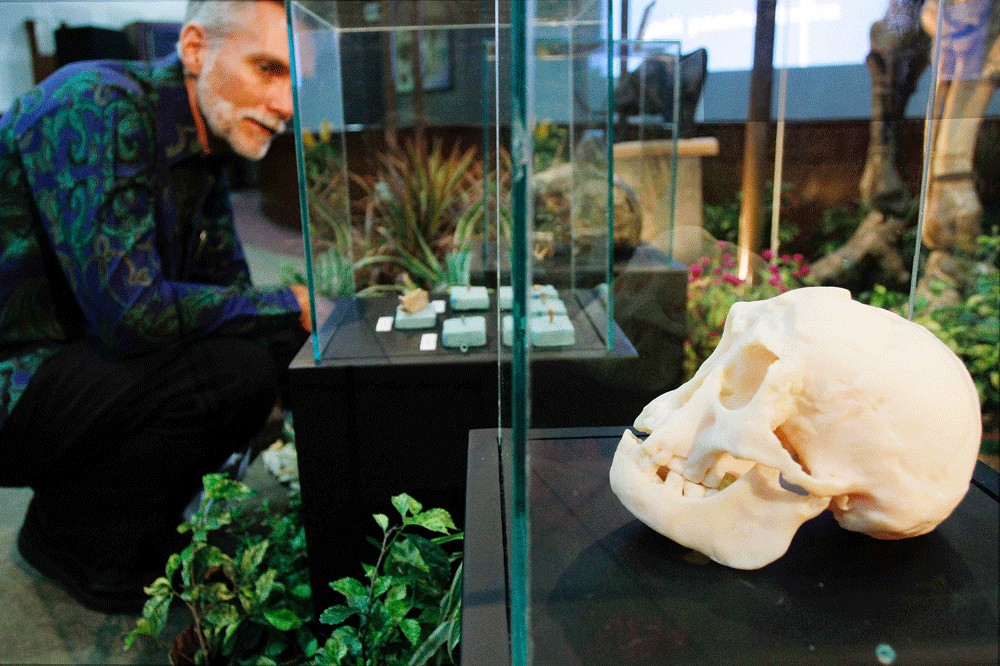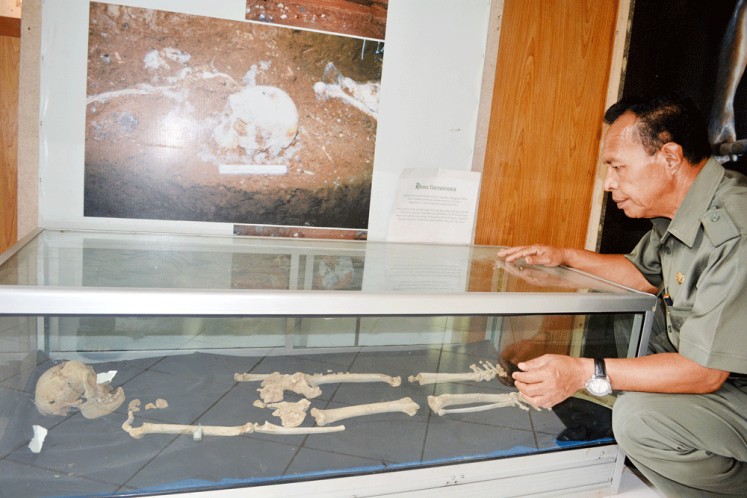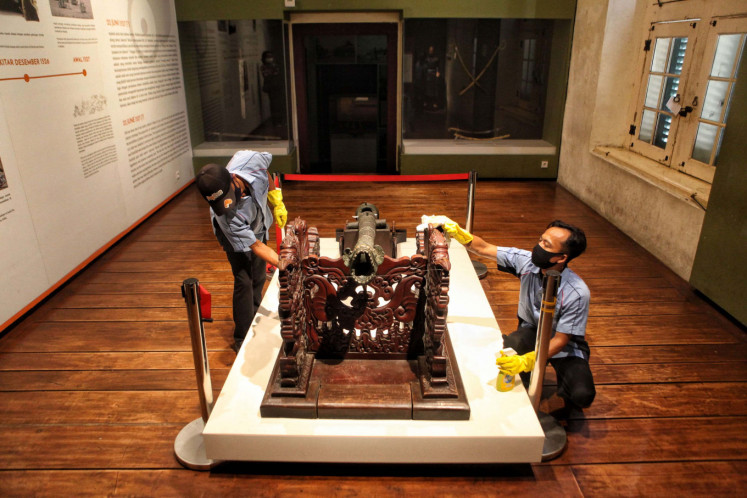Understanding flo the 'hobbit' of Liang Bua
Liang Bua, a cave on the island of Flores, gives a glimpse into the life of the “hobbits” who were wiped out by a huge volcanic explosion about 50,000 years ago.
Change text size
Gift Premium Articles
to Anyone
 Head to head: Mark W. Moore, a senior lecturer from the University of New England, observes a skull replica of Homo floresiensis. (The Jakarta Post/Arya Dipa)
Head to head: Mark W. Moore, a senior lecturer from the University of New England, observes a skull replica of Homo floresiensis. (The Jakarta Post/Arya Dipa)
Remarkable events happen at mundane moments.
It was getting late on Sept. 2, 2003, time for team co-director archeologist Thomas Sutikna, 37, to call it a day at the Liang Bua (Cool Cave) dig in Central Flores, East Nusa Tenggara.
The Australian-Indonesian expedition had found bits of stegodon, a now extinct small elephant, and some stone tools. Interesting, but unexceptional, for the site had been dug over in the past though not deeply.
A thousand meters up in the Manggarai Highlands, the weather is generally benign. Although shoveling sediment and shoring up diggings were tough, the environment was not. Problems were heavy rains scouring tracks, and as the island east of Bali is part of the Pacific Rim of Fire, the shakes.
Then came the quake that shook our understanding of human history. Assistant archeologist Benyamin Tarus was almost 6 meters down in a 4 square-meter pit. His tools swept the dirt as they had done numerous times. But this was different.
The local veteran of many digs shaved off the left eyebrow ridge of a skull; it was the kindest cut because Tarus’ trowel sliced through conventional thinking on the origins of humanity.
He slowly exposed a cranium, then bones. “Fragile and soft,” recalls Sutikna.
Liang Bua was shelter — and gravesite. No headstone, so let us call her Flo after her homeland.
She had been buried where she lay. Resurrected more than 60,000 years after her death into a vastly different universe grappling to understand its origins; perhaps she could help show the way.
The scientists were astonished — they had been seeking an early relative of Aboriginal Australians. Not Flo, though it took months of research to learn more.
Conventional wisdom has humans evolving in Africa and then spreading around the world. Suppose we had originated in Asia? Was Flo, and others discovered later, human?
No. Although popularly known as hobbits, after the little folk in The Lord of the Rings trilogy, their scientific name is Homo floresiensis, not Homo sapiens(wise man). Their group is australopithecines, extinct relatives of humans, walking upright but with different anatomies.

“Now the questions are different,” said Sutikna, just returned from another dig at Liang Bua and working with scientists from Indonesia, the United States, Canada, the Netherlands, Germany and Australia.
Their findings, just published in the Journal of Human Evolution, reinforce the Big Bang idea — that dust and debris from a mighty volcanic blast wiped out Homo floresiensis who were later replaced by Homo sapiens.
“Where did Flo come from, and how did she get there?” Sutikna added. “Flores has never been connected to other islands. Does she have relatives elsewhere? We just don’t know. Finding Flo was the most exciting moment in my career."
Not just a moment for Sutikna, but for the world. Yet, Indonesia has still to recognize the importance of Liang Bua.
Sutikna, now an academic at Australia’s University of Wollongong, has many questions and few answers. Not because he evades, but because archeology is like working in a room with many doors and one key; this eventually opens into another room with even more locked doors.
Flo’s small size, just 1.1 m, thick forearms and lightweight — maybe 30 kilograms — suggests that she was a tree climber, handy when dodging the snapping jaws of Komodo dragons.
By the standards of modern humans, she would have been athletic but no marathon runner as her feet were big and flat.
Her broad pelvis meant she had a pot belly. Her arms would have been more to the front than sides, so she could not have thrown stones. That useful survival skill was yet to evolve.
Yet to be recognized

There are eight UNESCO World Heritage sites in Indonesia. The most famous is Borobudur, the ninth century Buddhist temple in Central Java. It sees an average 7,000 sightseers a day.
Another is the Surakarta “fossil man” site with an excellent museum about 15 kilometers outside the city. Weekends are especially busy.
Liang Bua, which is four hours drive east of Labuan Bajo, is not on the list. It gets three or four visitors a day, mainly from Europe. Occasionally, an Australian or Indonesian drops by.
The cave is hauntingly spectacular, big enough for a lecture theater; about 50 meters wide at the mouth and 20 m high but it may have been larger — or smaller — during other geological upheavals. It slopes to a high back, ideal for avoiding predators.
Drooping from the roof is a forest of warped stalactites, strangely shaped by water seeping through mineral soils. Exposed tree roots pattern the walls. Bats roost among the crannies.
There is a small museum set up with funds from Indonesia’s National Archeology Research Center (Arkenas), the universities of Woolongong and New England, as well as the Smithsonian’s Human Origins Program. But there is little for maintenance and improved access.
The museum needs upgrading, the surrounds purged of plastic. The site’s global significance warrants high-tech displays and knowledgeable multilingual staff.
Jatmiko, now an Arkenas senior researcher, was on the discovery team with Sutikna. “Promoting Liang Bua is a good idea which I support,” he said. “But you must understand that managing and making it a tourist destination isn’t easy.
“Every year, we excavate in the cave and we always ensure officials know it’s of world importance for studying human evolution, and for tourism. For a long time, we’ve tried to collaborate with the local government, but got no response.”
Jatmiko and his team at Arkenas are also busy digging another site nearby, Soa Basin, where 400,000-year-old fossils have been found.
But there’s only one Liang Bua, hobbit home, little known, rarely seen.






